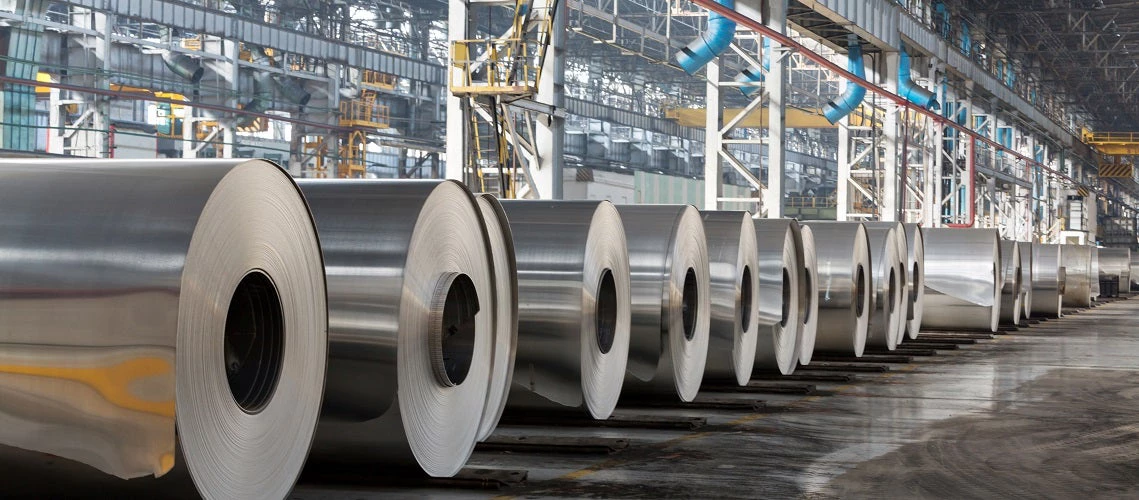 Row of rolls of aluminum lie in production shop of plant
Row of rolls of aluminum lie in production shop of plant
(This post has been updated to reflect changes in methodology and data.)
In January 2026, the European Union will require importers of certain carbon-intensive goods to pay for their products’ embodied carbon emissions. The policy, known as the Carbon Border Adjustment Mechanism (CBAM), could raise the cost of exporting these goods to the EU market, potentially affecting the competitiveness of exporters.
To help developing countries assess the potential impact on their competitiveness, the World Bank devised four indexes. In this blog post, we focus on two of them. One looks at the exposure of sectors, the other at the exposure of economies. We find that although individual sectors with high emission intensities could lose market share in the EU, the overall economic exposure to CBAM charges is small in most cases.
Before we delve into the details, here is some background. The CBAM seeks to level the playing field between EU producers of carbon-intensive goods, such as steel and cement, and their foreign competitors. Importers will therefore be required to pay the same price as EU-based companies for greenhouse gases emitted in the production of those goods. The goal is to prevent so-called carbon leakage, which happens when production shifts to places where the price of emitting greenhouse gases—and therefore the cost of production—is lower.
The CBAM complements the Emissions Trading System (ETS), the cornerstone of the EU’s policy to cut greenhouse-gas emissions. Under it, the EU sets annual caps on allowable emissions from industries covered by the plan and auctions or distributes ETS allowances, which are tradable on secondary markets. A company must obtain and surrender allowances corresponding to its emissions each year; if it wishes to emit more than its allocation, it must buy more allowances. The trading sets a price on carbon, providing an incentive for firms to reduce emissions. Allowances have been trading in the range of €74–100 (US$86–116) per metric ton of CO2 over the last two years.
The CBAM initially covers six emission-intensive products: aluminum, iron and steel, cement, fertilizers, electricity, and hydrogen. It includes direct emissions (scope 1) for all products and indirect emissions (scope 2) from the use of electricity in production of cement and fertilizer. In later years, the CBAM will likely be expanded to cover additional carbon-intensive goods.
An exporter’s exposure to the CBAM (measured at a sectoral level) depends on two factors: how much more (or less) carbon it uses in production of the CBAM product compared with the average EU producer, and how much it depends on exports to European markets. But there is an important caveat. Our measure is drawn from sector-wide averages, not individual firms' emissions. Firms that produce goods like steel for export may be cleaner than those that produce them for the domestic market. In that case, our metric may overstate exporters’ exposure to CBAM. (Readers interested in other technical wrinkles can consult our methodological note)
To measure how much carbon costs add to production—what we call the carbon-cost intensity—we use a price of USD100 per metric ton of carbon dioxide, which is roughly what companies pay in the EU's carbon market today. We multiply this price by the amount of carbon dioxide to get the carbon-cost intensity. So, for example, if a steel plant outside of the EU emits twice as much carbon dioxide as the average EU steel plant, it will face much higher carbon costs when selling to the bloc. This difference in carbon-cost intensity determines the change in competitiveness: who wins or loses under CBAM.
One of our indexes is the Trade Exposure Index. It measures the degree to which excess carbon payments—how much more an importer will pay compared with EU producers of the same product—could affect a country's competitiveness in a particular sector. To get an index, we divide excess carbon payments by the value of exports to the world in a sector. Countries with high index scores would struggle in the EU market and risk losing market share. Clean producers that emit less than the EU average will become more competitive and could gain market share.
Consider Mozambique, which sends 97 percent of its aluminum exports to the EU. The country's aluminum industry emits 0.8 kilograms of carbon dioxide for every US dollar of exports. That is 7.4 times more than the average EU aluminum producer (figure 1). Mozambique records the highest index score, indicating that its excess carbon payments are equal to 6 percent of the value of its aluminum exports to the world (figure 2). Mozambique’s aluminum exporters might face higher carbon payments than EU producers, leading to loss of competitiveness in the EU market. (See CBAM Exposure Indexes dashboard)
On the other hand, Ghana, Uzbekistan, and Jordan have lower emission intensities than the average EU producer of aluminum; as a result, their CBAM Trade Exposure index is negative and ranges from minus 0.1 percent to minus 0.3 percent, potentially making their exports more competitive in the EU market.
Figure 1. The exposure of selected countries to the CBAM is determined by their carbon-cost intensity relative to the EU and dependence on the EU market.

Note: Countries are the top seven most exposed and three least exposed to CBAM. Countries with export values of all CBAM products to the EU over USD 1 million are included in our sample. 2017 Emission intensity data is from the GTAP11-CE, while 2022 trade data is from World Bank’s World Integrated Trade Solution. The results of CBAM exposure indexes depend on the data sources of emission intensity and trade.
Another gauge is the CBAM Economic Exposure Index. It measures total excess carbon payments across all CBAM products as a share of a country’s GDP. For most countries, the economic impact of CBAM is minimal. In figure 3, Mozambique has the highest exposure at 0.6 percent of GDP, followed by Ukraine (0.5 percent) and Egypt (0.2 percent). All other countries face exposure of less than 0.1 percent of GDP.
Both CBAM exposure indexes help identify the countries that would benefit from domestic action or international assistance to reduce the unpriced carbon content of their industrial products and help improve competitiveness in EU markets. A first step is to monitor and verify current emissions from facilities to better assess actual exposure and help relatively clean firms document their intensities.
A next step is to consider domestic carbon pricing options; for example, Kazakhstan, South Africa, Ukraine, and others have implemented carbon pricing mechanisms. However, at less than USD20 per metric ton of carbon dioxide in each case, prices are significantly lower than in the EU. Developing countries have until January 1, 2026, to help their exporters get ready, with support from The World Bank Group and other international financial institutions.
This research was supported by the Umbrella Facility for Trade trust fund, which receives contributions from the governments of the Netherlands, Norway, Sweden, Switzerland, and the United Kingdom.
Related content:
Dashboard: CBAM Exposure Indexes
Methodology: Download pdf
Chart: CBAM’s impact on exports to the EU
Blogs:
The Philippines can use trade policy to advance climate and labor goals
Why tariffs for green technologies should be kept low in developing countries
Developing countries can benefit from climate policies of world’s biggest economies





Join the Conversation